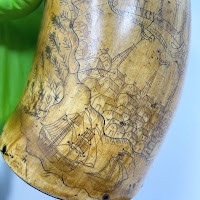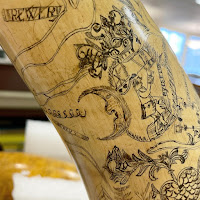 |
| Close up of powder horn. Image of Lion and Coat of Arms. |
Morristown NHP has several dozen powder horns in our collection. They vary in size and in decoration and many are adorned with intricate etchings. Fashioned out of hollowed cow horns, powder horns were used to carry and keep black powder (gun powder) dry. Carving one’s powder horn is a folk-art tradition most identified with colonial war practices in North American theaters, roughly between 1750-1783. These artifacts were especially prominent during the Seven Years War (the French and Indian War, in particular) and continued into the American Revolution (1775-1783).
The powder horns featured here are likely from soldiers skirmishing in upstate New York as many of the cities and waterways depict New York and the Canadian border. One has a clear date ‘1759’ inscribed. Subjected to long periods of waiting, people took to carving their horns with gravers, needles, and pen knives. Oils, ash, ink, and wax were likely used to give the grooves their contrasting color. Common etchings include maps, animals, encounters, whimsical figures, coats of arms, names (both of master carvers and of owners of horns), forts, scrolls, and expedition dates. These interesting ‘scrapbooks’ of sorts are historical snapshots of journeys, thoughts, landscapes, and can sometimes even indicate the literacy level of the artist.
Etchings of a unicorn, mermaid, and the year "1759."








No comments:
Post a Comment